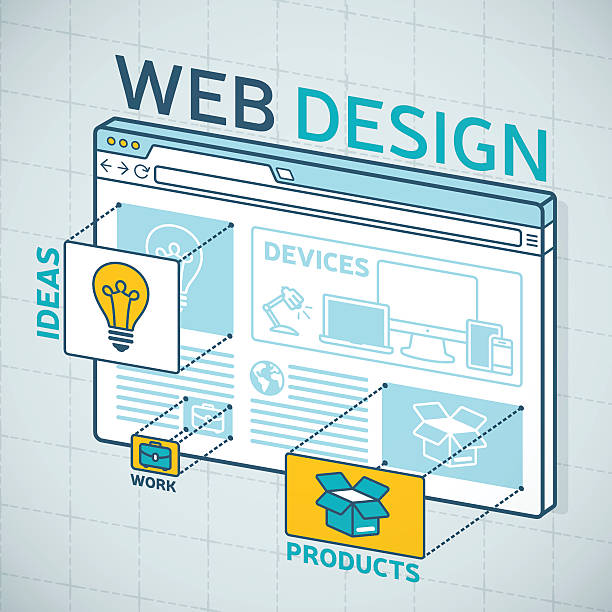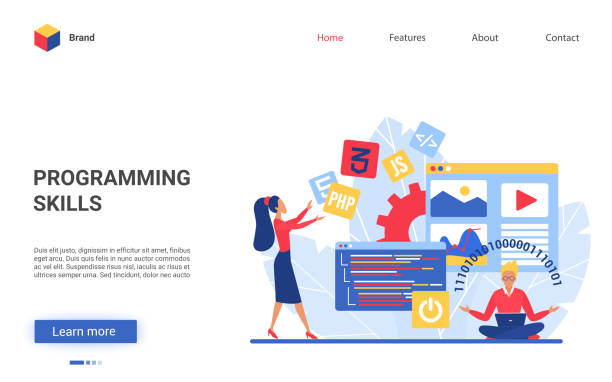What is Responsive Web Design and Why is it Important?

#In the current digital age, users access the internet using various devices; from smartphones and tablets to laptops and desktop monitors.
This diversity in screen sizes necessitates a new approach to web design.
Responsive Web Design is the answer to this need.
This concept, first introduced by Ethan Marcotte in 2010, means creating websites that can automatically adapt their layout and content to the size and orientation of the user’s screen.
#Instead of having separate versions for each device, a responsive website has a single codebase that makes itself scalable and flexible using specific CSS and HTML techniques.
This approach not only improves user experience but also simplifies the website’s maintenance and update process.
Imagine a user visiting your website with their phone; if your site is not responsive, they will have to constantly zoom and scroll horizontally to view the content, which is an unpleasant experience.
But with a responsive design, the content is automatically rearranged, and readability improves.
This is a fundamental principle in modern web design that ensures your website is displayed optimally on any device.
The importance of responsive web design goes beyond mere visual aesthetics; it is a necessity for survival in today’s competitive market.
Is your online sales not as you expect? With Rasaweb, permanently solve the problem of low sales and poor user experience!
✅ Increase visitor-to-customer conversion rate
✅ Create an enjoyable user experience and increase customer trust
⚡ Act now to receive a free consultation!
Why Does Every Business Need Responsive Design?

#In today’s world, where online competition has reached its peak, simply having a website is not enough; your website must be efficient and accessible to all users, regardless of their device.
The main reason every business needs responsive web design is changing consumer behavior.
Statistics show that a significant portion of web traffic comes from mobile devices.
If your website does not display well on mobile, you will easily lose potential customers.
#One of the most important reasons is its impact on SEO.
Google, as the largest search engine, prefers responsive websites in its rankings.
Google’s algorithms rank websites that provide a good mobile user experience higher.
This means that if your site is not responsive, you will likely rank lower than your competitors in search results, and your business’s visibility will decrease.
Furthermore, a responsive website is easier to maintain; instead of managing multiple versions of the site (one for desktop, one for mobile, etc.), there is only one version, which is simpler to update.
This saves both time and money.
Responsive web design also helps increase conversion rates because users can easily find the information they need and perform desired actions, whether it’s purchasing a product or filling out a contact form.
Fundamental Principles and Key Components of Responsive Design

#To achieve a successful responsive web design, there are three key components, each playing a vital role in adapting the website to different devices.
These principles include Fluid Grids, Flexible Images, and Media Queries.
#**1.
Fluid Grids:** Instead of using fixed pixel dimensions, percentages and relative units (like em or rem) are used to define the width and height of elements.
This means that the width and height of elements on your website are not fixed, but change proportionally with the user’s screen size.
This approach ensures that the overall layout of the website remains proportionate and readable at any size.
#**2.
Flexible Images:** Images can be one of the most challenging parts of responsive design.
Flexible images refer to images that can adjust their size to their parent container.
This is often achieved using the CSS property `max-width: 100%;` for images, which ensures the image never overflows its container and always remains within view.
Additionally, more advanced techniques such as `srcset` in HTML5 are used to provide images with different resolutions for various devices.
#**3.
Media Queries:** These are the intelligent part of responsive web design.
Media queries are CSS rules that tell the browser which styles to apply based on specific device characteristics (such as screen width, orientation, resolution, etc.).
For example, you can define that if the screen width is less than 768 pixels, the menu changes from horizontal to vertical, or fonts become smaller.
This capability allows designers to optimize the user experience for every screen size.
#By combining these three principles, designers can create websites that are not only beautiful but also fully compatible with the needs of users on different devices.
| Component | Explanation | Practical Example |
|---|---|---|
| Fluid Grids | Using relative units (percentages, em, rem) for element dimensions instead of fixed pixels. | `width: 100%;`, `padding: 2% 4%;` |
| Flexible Images | Images automatically adjust their size to their parent container to prevent overflow. | `img { max-width: 100%; height: auto; }` |
| Media Queries | Applying different CSS styles based on device characteristics (width, height, orientation). | `@media screen and (max-width: 768px) { …}` |
Effective Tools and Frameworks in Responsive Design

#Developing a responsive website design from scratch can be time-consuming and complex.
Fortunately, the web development community has provided powerful tools and frameworks that greatly simplify this process.
These tools help developers create responsive websites with greater speed and efficiency.
#One of the best-known and most widely used frameworks is Bootstrap.
Bootstrap is a free and open-source CSS, HTML, and JavaScript framework that offers a wide range of pre-built UI components (such as buttons, forms, navigation menus, and a responsive grid system).
This framework is designed with a “mobile-first” approach, allowing you to quickly create responsive layouts.
#Another popular framework is Foundation.
Like Bootstrap, Foundation is also a mobile-first framework, but it offers more flexibility for customization compared to Bootstrap and is suitable for larger projects with more specific needs.
#In addition to CSS frameworks, other tools are crucial for image optimization (like TinyPNG or ImageOptim) and page load speed management (like Google PageSpeed Insights).
Also, using CSS preprocessors like Sass or Less can organize and make the process of writing CSS for responsive styles more maintainable.
#These tools and frameworks, by providing a strong foundation and a set of ready-to-use components, allow you to focus on the unique aspects of your website and avoid reinventing the wheel from scratch.
This is great news for development teams looking to implement responsive web design efficiently.
Are you losing business opportunities because of an outdated website? With Rasaweb, permanently solve the problem of not attracting potential customers through your website!
✅ Attract more high-quality leads
✅ Increase brand credibility in the eyes of customers
⚡ Get a free corporate website design consultation
Improving User Experience with Responsive Design

#User Experience (UX) is the backbone of any successful website.
No matter how beautifully designed a website is, if it fails to provide a satisfactory user experience, it will fail to attract and retain users.
Responsive web design plays a very important role in improving UX because it ensures that users, regardless of the device they use, are presented with an optimized and efficient user interface.
#With a responsive design, content is organized in a way that is easily readable and navigable on any screen size.
For example, on smaller screens, columns may stack vertically, or navigation menus may collapse into a hamburger button.
These intelligent changes prevent clutter and keep the user’s focus on the main content.
#Furthermore, responsive web design increases accessibility.
Users do not need to zoom, scroll horizontally, or struggle to click on small buttons.
This ease of interaction reduces frustration and encourages users to stay on the site longer.
Also, page load time is an important UX factor.
Responsive websites, by optimizing images and using conditional loading techniques, can load faster on mobile devices, which directly affects user satisfaction.
#This approach not only improves the visual experience but also considers touch capabilities, making button and form designs more suitable for finger interaction.
Ultimately, a website with responsive web design conveys a sense of professionalism and attention to detail to the user, which in turn builds trust and loyalty among customers.
SEO Benefits of Responsive Web Design

#In the world of online search, Search Engine Optimization (SEO) is essential for a website’s success.
Responsive web design not only improves user experience but also offers significant SEO benefits that help your website achieve higher rankings in search results.
#One of the biggest SEO advantages is having a single URL for all devices.
In the past, websites often had separate mobile versions (e.g., `m.example.com`), which led to duplicate content and SEO issues.
With a responsive website, Google only needs to crawl and index one version of your site.
This is easier for both search engines and webmasters and prevents problems related to duplicate content.
#Google has explicitly stated that it recommends responsive websites as the preferred method for delivering mobile-friendly content.
This means that responsive websites have an advantage in mobile search result rankings.
Since Google uses a “mobile-first” indexing strategy, the mobile version of your site is primarily used to determine its overall ranking.
Therefore, if your site performs well on mobile, you will have a better chance of ranking well in desktop searches too.
#Furthermore, responsive web design helps reduce the bounce rate and increase user dwell time.
When users have a good experience on your site, they stay longer and view more pages.
These signals are very positive for search engines and indicate that your content is valuable and relevant, ultimately leading to improved SEO rankings.
Improved page load speed is another important SEO factor often associated with responsive design, helping your website become accessible to users faster.
Common Challenges and Solutions in Responsive Web Design

#While responsive web design offers countless benefits, its implementation can come with challenges that require smart planning and solutions.
Understanding these challenges and preparing for them is a crucial part of the design and development process.
#**1.
Image Optimization:** One of the biggest challenges is ensuring fast loading of images on various devices without compromising quality.
Large images can significantly increase page load time, especially on slow mobile connections.
#* **Solution:** Use techniques like `srcset` and `picture` in HTML5 to deliver images with different dimensions and resolutions for various devices, compress images with optimization tools (such as WebP), and implement lazy loading.
#**2.
Performance:** Responsive websites may experience performance degradation due to loading additional CSS and JavaScript to support different layouts.
#* **Solution:** Optimize CSS and JavaScript code (Minification and Concatenation), use a CDN (Content Delivery Network) for faster content delivery, and remove unnecessary code.
#**3.
Complex Navigation:** Navigation menus that work well on desktop may become cumbersome on smaller devices.
#* **Solution:** Design responsive navigation menus such as hamburger buttons, dropdown menus, or full-screen mobile navigation that are easy to use.
#**4.
Legacy Content:** If your website has a lot of content built for non-responsive design, converting it can be challenging.
#* **Solution:** Careful planning for content migration, using a gradual approach (e.g., starting with new pages and then redesigning old ones), and considering “mobile-first” design principles from the outset.
#**5.
Testing and Debugging:** Ensuring that the website displays correctly across all devices and browsers requires extensive testing.
#* **Solution:** Use browser developer tools, device emulators, and perform tests on real devices to identify and fix issues.
#By considering these challenges and implementing appropriate solutions, a strong and efficient responsive web design can be created that delivers a flawless user experience across all platforms.
| Challenge | Explanation | Solution |
|---|---|---|
| Image Optimization | Large images reduce loading speed. | `srcset`, `picture`, compression, Lazy Loading. |
| Performance | Loading extra CSS/JS can slow down the site. | Minification, Concatenation, CDN, removal of unnecessary code. |
| Complex Navigation | Desktop menus are inefficient on mobile. | Hamburger menus, dropdowns, full-screen mobile navigation. |
| Legacy Content | Converting existing content to responsive format. | Phased migration, “mobile-first” approach in redesign. |
| Testing and Debugging | Ensuring correct functionality across all devices and browsers. | Developer tools, emulators, testing on real devices. |
Testing and Debugging Tools for Responsive Design

#After implementing responsive web design, the critical phase of testing and debugging begins.
Ensuring that your website displays correctly and performs optimally across all screen sizes, orientations, and browsers requires the use of appropriate tools.
Without thorough testing, visual or functional errors may remain hidden, disrupting the user experience.
#One of the simplest yet most powerful tools is Browser Developer Tools.
Almost all modern browsers like Chrome, Firefox, and Edge have the capability to simulate mobile devices.
Using these tools, you can change screen dimensions, switch orientation from landscape to portrait, and even simulate slower networks.
This allows you to see how your website behaves under different conditions.
#In addition to built-in browser tools, online responsive testing platforms also exist.
Websites such as Responsive Design Checker or BrowserStack Responsive Design Test allow you to enter your website’s URL and view it simultaneously on multiple different screen sizes.
These tools are very useful for a quick layout check across common dimensions.
#However, no simulation can fully replace testing on real devices.
There are subtle differences in browser rendering engines, actual pixel sizes, and touch interaction in physical devices.
Therefore, having a collection of mobile devices and tablets with different operating systems (iOS and Android) is essential for final testing.
Also, using tools like Google PageSpeed Insights is highly recommended to evaluate your website’s performance and user experience on both mobile and desktop.
Does your current website showcase your brand’s credibility as it should? Or does it scare away potential customers?
Rasaweb, with years of experience in professional corporate website design, is your comprehensive solution.
✅ A modern, beautiful website consistent with your brand identity
✅ Significant increase in lead and new customer attraction
⚡ Contact Rasaweb now for a free corporate website design consultation!
The Future of Responsive Web Design and Emerging Trends

#With continuous advancements in web technology and the emergence of new devices, the future of responsive web design is also evolving.
What is considered “best practice” today may be replaced by novel approaches tomorrow.
Understanding these emerging trends is essential for any designer and developer who wants to be a leader in this field.
#One important trend is Adaptive Design versus responsive design.
While responsive design relies on a fluid and flexible layout, adaptive design provides a set of predefined fixed layouts for specific screen sizes.
This approach can have advantages for some projects that require more precise control over the layout at specific breakpoints, but its implementation is more complex.
#Another trend is a greater focus on Component-Based Design.
Using frameworks like React, Vue.js, and Angular, websites are divided into a collection of independent components, each of which can be designed responsively and then assembled together.
This approach increases code reusability, scalability, and easier maintenance.
#New advancements in CSS also contribute to the future of responsive web design.
Features like Container Queries allow designers to apply styles based on the size of an element’s parent container, not just the entire viewport.
This brings unprecedented flexibility and makes designing independent, responsive components much easier.
Additionally, Fluid Typography, which adjusts font sizes based on viewport size, will help improve readability across all devices.
The emergence of artificial intelligence in design tools can also automate the process of creating responsive layouts.
The Importance of Investing in Responsive Web Design for Your Business’s Future

#At the end of this comprehensive discussion, we once again emphasize the vital importance of responsive web design for the long-term success of any business.
Responsive design can no longer be considered a luxury option or a competitive advantage; it is an undeniable necessity for any website seeking to reach a wide audience and provide an exceptional user experience.
#Investing in responsive web design means investing in the future of your business.
This not only increases your visibility in search engines and attracts more traffic, but it also directly impacts your conversion rate and, consequently, your profitability.
Today’s users have high expectations; they expect your website to load quickly on any device, be easily navigable, and provide the information they need effortlessly.
Failing to meet these expectations means losing customers to competitors.
#A responsive website conveys a message of trust and professionalism to your audience.
It shows that you care about your users’ needs and are willing to invest in providing the best possible experience.
Furthermore, given current and future web trends, responsive web design helps you remain resilient to technological changes and avoid the need for costly and time-consuming redesigns in the near future.
#Considering all the benefits discussed – from improved SEO and user experience to reduced maintenance costs and increased conversion rates – now is the best time to evaluate your website and ensure its responsiveness.
This is a strategic step that will guarantee your digital success in the years to come.
Frequently Asked Questions
| Question | Answer |
|---|---|
| What is Responsive Web Design? | The design of a website whose appearance and layout automatically adapt to the screen size of the user’s device (such as computer, tablet, mobile) to provide an optimal user experience. |
| Why is responsive design important? | Given the variety of devices users use to view websites, responsive design improves user experience, reduces bounce rate, increases time spent on the site, and improves SEO. |
| What are the main principles of responsive design? | The three main principles include Fluid Grids, Flexible Images, and Media Queries. |
| What is a Media Query and what is its role in responsive design? | A Media Query is a CSS capability that allows you to apply different styles based on display device characteristics such as screen width, height, resolution, and media type. This tool is considered the heart of responsive design. |
| What is the difference between Mobile First and Desktop First approaches in responsive design? | In the Mobile First approach, design and coding are first done for small screens (mobile), and then styles are added for larger screens using media queries. In the Desktop First approach, the opposite is done; first designed for desktop and then adapted for smaller screens. The Mobile First approach is generally recommended. |
And other services of Rasaweb Advertising Agency in the field of advertising
Smart UI/UX: A fast and efficient solution for customer acquisition focusing on attractive user interface design.
Smart Google Ads: A professional solution for customer acquisition focusing on precise audience targeting.
Smart SEO: Designed for businesses seeking digital branding through Google ad management.
Smart Advertising Campaign: A dedicated service for growth in customer behavior analysis based on proprietary programming.
Smart Marketing Automation: Designed for businesses seeking user engagement through intelligent data analysis.
And over hundreds of other services in the fields of internet advertising, advertising consulting, and organizational solutions
Internet Advertising | Advertising Strategy | Advertorials
Resources
Comprehensive Guide to Responsive Web DesignPrinciples of Responsive Web DesignWhat is Responsive Design?Responsive Website Design Tips
? Are you ready for your business to be seen in the online world? Rasaweb Afarin Digital Marketing Agency, with years of experience and expertise in the digital field, is by your side to turn your dreams into reality. We help you attract more audiences and experience sustainable growth by providing innovative and creative solutions, including fast and optimized website design, professional SEO, social media management, and targeted advertising. With Rasaweb Afarin, the future of your business begins today.
📍 Tehran, Mirdamad Street, next to Bank Markazi, Kazeroun Jonoubi Alley, Ramin Alley, No. 6


